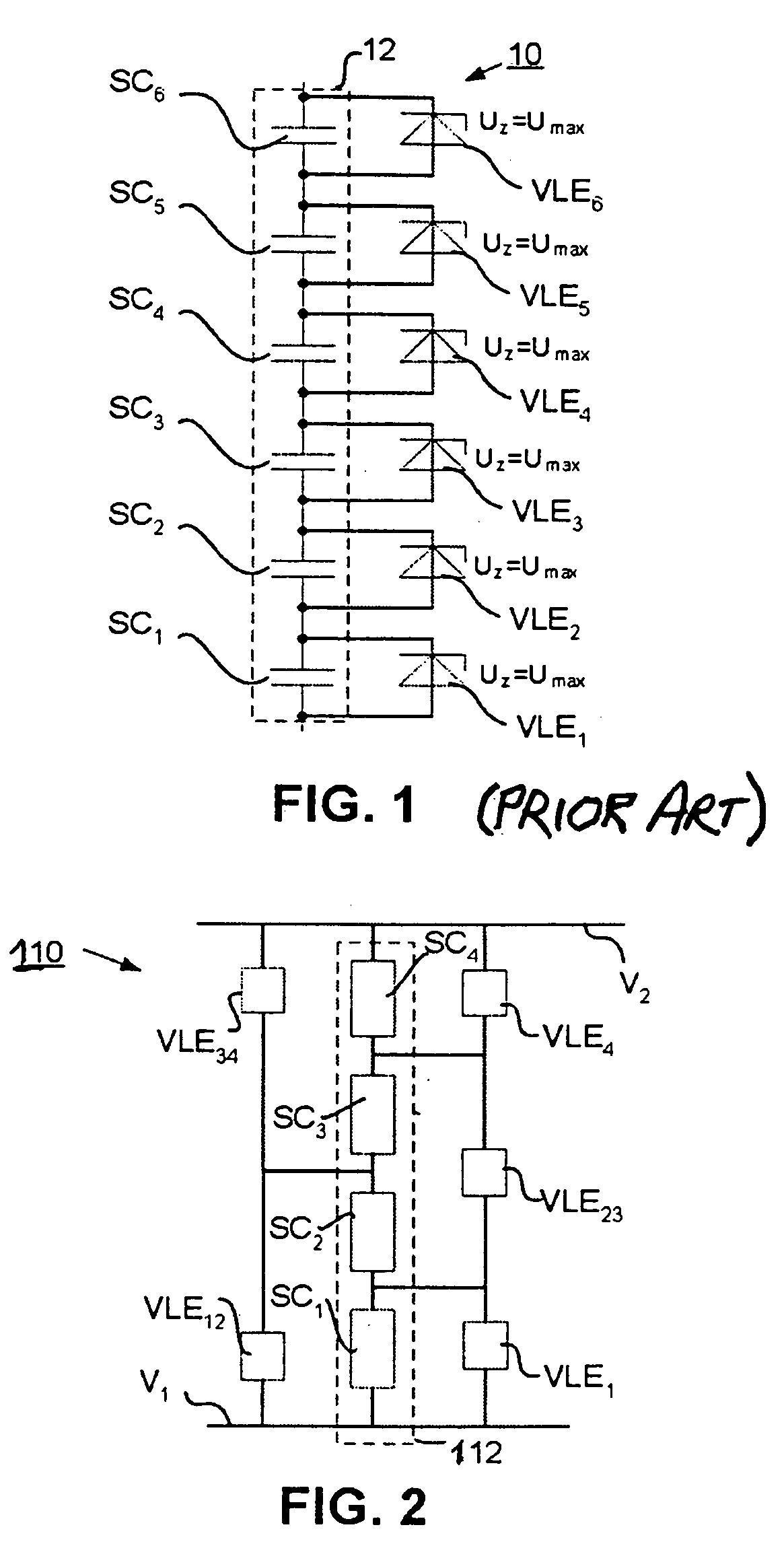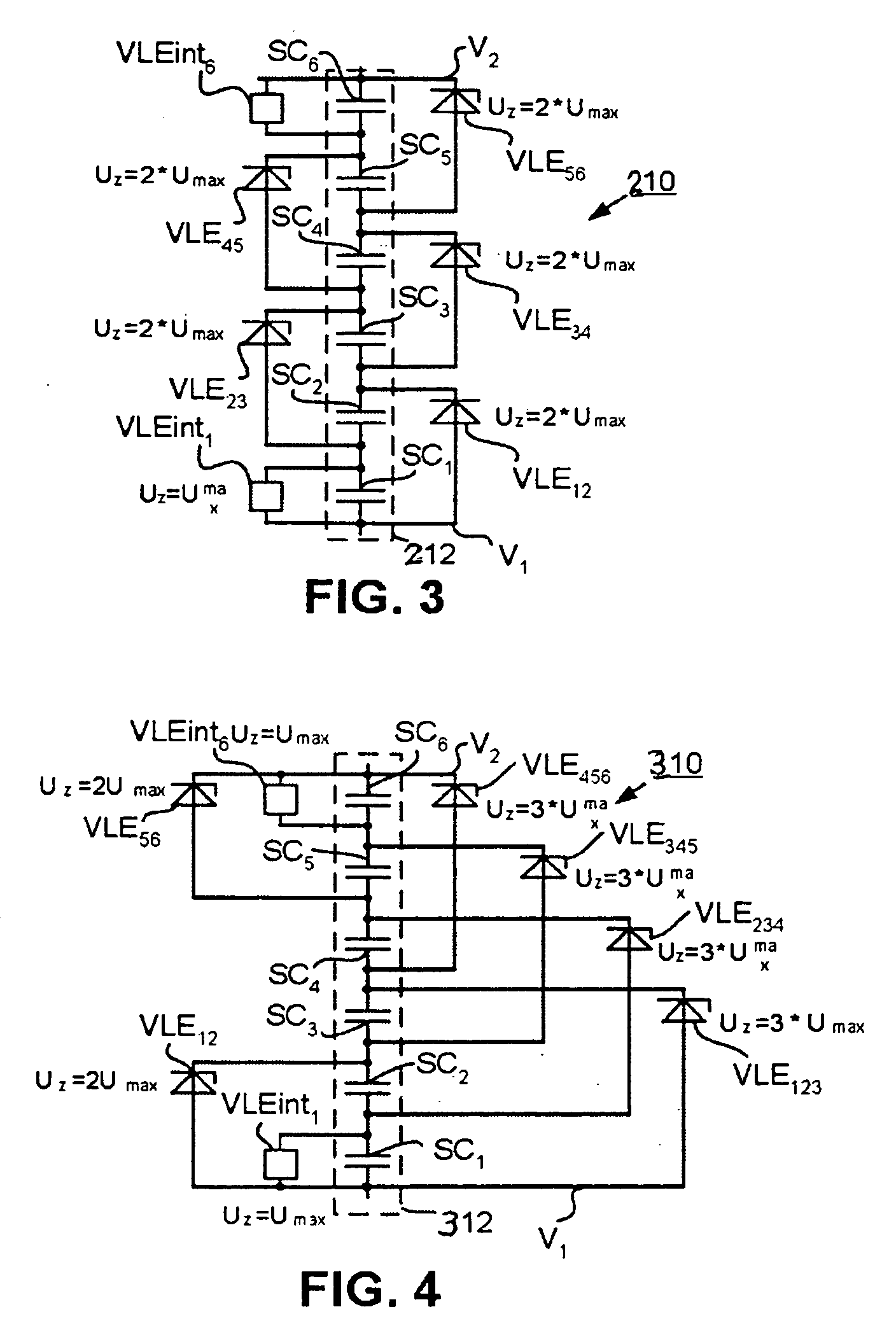[0009] Accordingly, it is an object of the present invention to give an over-voltage protection for modules of energy storage elements which can be realized in simple and economic manner and which ensures reliable protection against damage of energy storage elements in the case of over-voltages.
[0010] It is another object of the present invention to give, in the case of use of super-capacitors in energy storage modules, a circuit arrangement which prevents damage of energy storage elements in the event of over-voltages due to tolerances in
capacitance.
[0011] The present invention is based on the notion that Zener diodes offer an economic and easily connectible possibility for voltage limitation. Since energy storage elements usually have a low permissible voltage and consequently have to be used in a series circuit in order to be able to store a greater level of charge, the obvious approach would be to connect in parallel with each energy storage element, as is already known from the state of the art, a
Zener diode with a small
breakdown voltage corresponding with the maximum permissible voltage of the corresponding energy storage element. Since, however, the Zener diodes have for low voltages a gentle, relatively soft characteristic curve which already allows flow of a
discharge current at voltages below the
breakdown voltage this is disadvantageous for the
overall efficiency of the energy storage module. The storage life of the overall module is reduced by the
discharge current already flowing prior to the breakdown voltage. On the other hand, Zener diodes with a higher breakdown voltage have a steeper characteristic curve, so that a current flows only on attainment of the breakdown voltage.
[0013] The series circuit can comprise any desired number of energy storage elements. The number “M” of the energy storage elements belonging to a combination of directly intercoupled energy storage elements can vary from circuit to circuit. Thus, in the case of a circuit of five energy storage elements, “M” can be selected to be equal to 2, 3, 4 or 5. A respective voltage-limiting element is connected in parallel with each combination of “M” energy storage elements. In addition, a respective voltage-limiting element is connected in parallel with the first and the nth energy storage element. Moreover, a respective voltage-limiting element is connected in parallel with all sub-combinations of at least two directly interconnected energy storage elements of the combination, which is connected to the first and the second potential. There thus results an intercalated arrangement of the voltage-limiting elements with respect to the energy storage elements with the characteristic that each energy storage element is bridged over by at least two, voltage-limiting elements and thus an over-voltage across an individual energy storage element is also recognized and prevented.
[0014] Since the maximum voltage of energy storage elements connected in series results from the sum of the maximum permissible voltages Umax, a
Zener diode with a breakdown voltage corresponding with M·Umax can be employed for voltage limitation over a combination of “M” directly interconnected energy storage elements. The maximum permissible voltage Umax of super-capacitors lies at, for example, approximately 2.3 V to 2.5 V and thus the maximum permissible voltage across a combination of two super-capacitors lies at a maximum of 2·Umax=5 V. For this reason economic Zener diodes with a breakdown voltage of 5 V can be used for voltage limitation, these diodes providing an economic over-voltage protection.
[0015] The voltage-limiting element across the first and the last or nth energy storage element of the series circuit of energy storage elements has to have a breakdown voltage corresponding with the maximum permissible voltage of the bridged-over first or nth energy storage element. In one simple realization, a respective
Zener diode of the breakdown voltage of 2.5 V is connected in parallel with the first and the last or nth energy storage element. This is disadvantageous to the extent that a Zener
diode with the small breakdown voltage of 2.5 V has a relatively soft characteristic curve and a
discharge current below the breakdown voltage. Accordingly, in an advantageous embodiment it is proposed to realize the voltage-limiting elements for the first and nth energy storage element by means of an
integrated circuit with an over-voltage protection function. Due to the intercalated arrangement of the voltage-limiting elements and the additional
safeguarding of the first and nth energy storage element an
overvoltage is securely diverted from every energy storage element although only simple Zener diodes are used for the over-voltage protection. It is thereby made possible to provide an economic over-voltage protection for all energy storage elements of an energy storage module and thus to protect the energy storage module, in the case of losses in
capacitance, against a possible total failure of energy storage elements.
 Login to View More
Login to View More  Login to View More
Login to View More 


